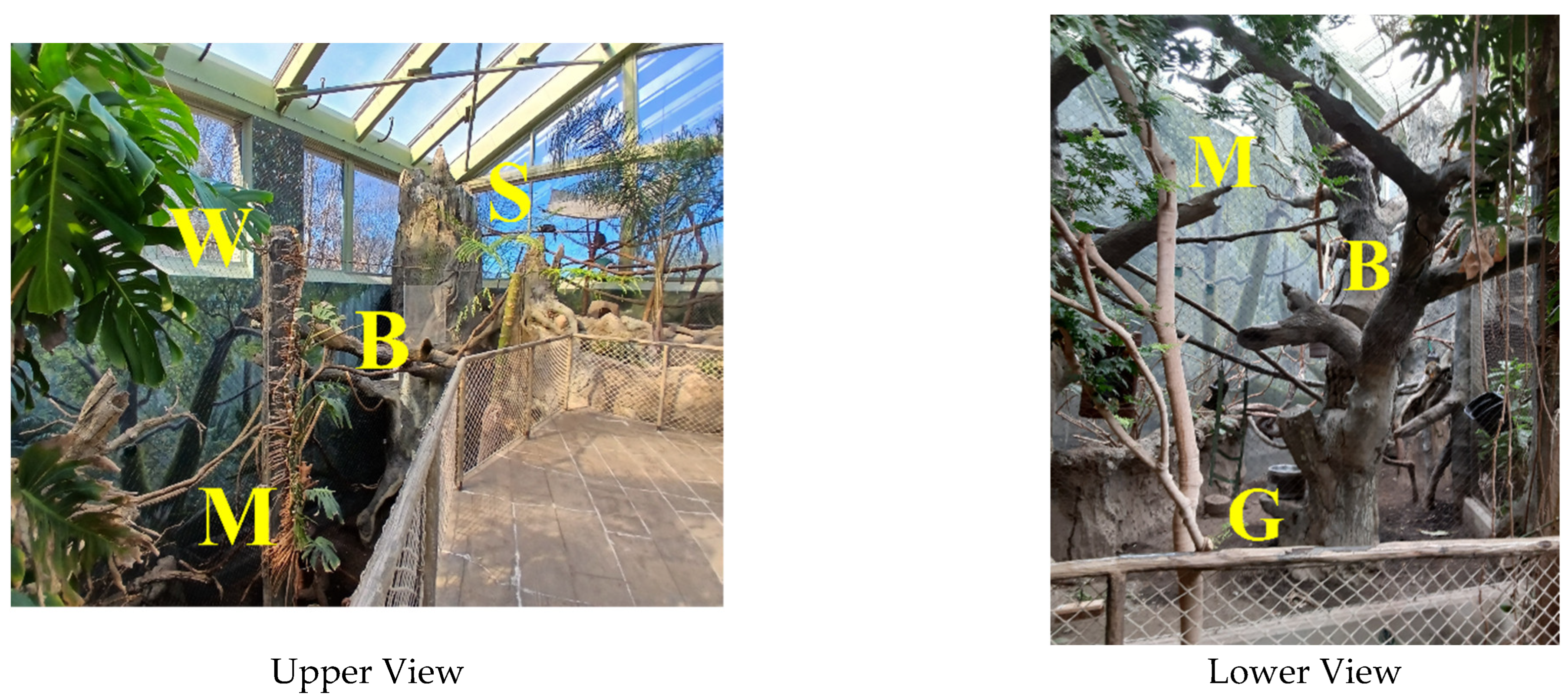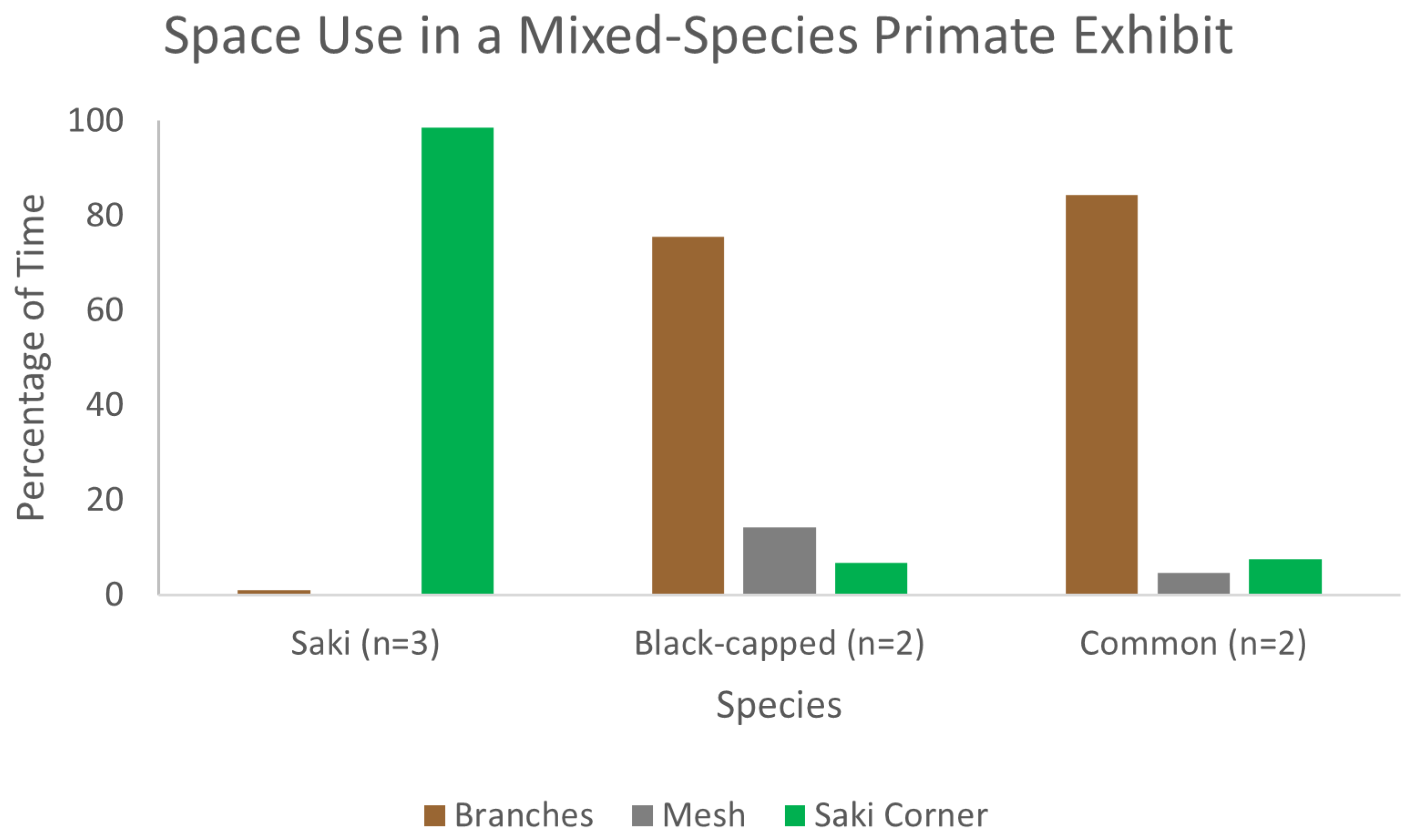Space Use Preferences and Species Proximity in a Mixed-Species Zoo Monkey Exhibit
Abstract
1. Introduction
2. Materials and Methods
2.1. Study Site and Subjects
2.2. Data Collection
2.3. Location Data
2.4. Neighbor Data
2.5. Behavioral Data
2.6. Data Analysis
3. Results
3.1. Space Use When Together
3.2. Space Use When Separated
3.3. Neighbor Distance
3.4. Neighbor Species
3.5. Behavior
4. Discussion
Supplementary Materials
Author Contributions
Funding
Institutional Review Board Statement
Data Availability Statement
Acknowledgments
Conflicts of Interest
Abbreviations
| AZA | Association of Zoos and Aquariums |
| DSCF | Dwass-Steel-Critchlow-Flinger Pairwise Comparisons |
| EAZA | European Association of Zoos and Aquariums |
References
- Dalton, R.; Buchanan-Smith, H.M. A mixed-species exhibit for Goeldi’s monkeys and Pygmy marmosets Callimico goeldii and Callithrix pygmaea at Edinburgh Zoo. Int. Zoo Yearb. 2005, 39, 176–184. [Google Scholar] [CrossRef]
- Daoudi-Simison, S.; Lee, P.; Buchanan-Smith, H. Using social network analysis to assess ‘groupness’ in a mixed-species zoo exhibit of tufted capuchins (Sapajus apella) and squirrel monkeys (Saimiri sciureus). Animals 2024, 14, 3360. [Google Scholar] [CrossRef]
- Wojciechowski, S. Introducing a fourth primate species to an established mixed-species exhibit of African monkeys. Zoo Biol. 2004, 23, 95–108. [Google Scholar] [CrossRef]
- Gentry, L.; Margulis, S.W. Behavioral effects of introducing pied tamarin (Saguinus bicolor) to black howler monkey (Alouatta caraya) and white-faced saki (Pithecia pithecia) in a zoological park. Am. J. Primatol. 2008, 70, 505–509. [Google Scholar] [CrossRef] [PubMed]
- Clark, F.E.; Melfi, V.A. Environmental enrichment for a mixed-species nocturnal mammal exhibit. Zoo Biol. 2011, 31, 397–413. [Google Scholar] [CrossRef] [PubMed]
- Green, H.; Palmer, G.A.; Brereton, J.E. An investigation into the perception and prevalence of mixed-species exhibits in zoos and aquaria. J. Res. Soc. Sci. Humanit. 2022, 1, 14–25. Available online: https://www.pioneerpublisher.com/jrssh/article/view/77 (accessed on 1 July 2025). [CrossRef]
- Law, S.; Prankel, S.; Schwitzer, C.; Dutton, J. Inter-specific interactions involving Lemur catta housed in mixed-species exhibits in UK zoos. J. Zoo Aquar. Res. 2021, 9, 247–258. [Google Scholar] [CrossRef]
- Casares, M.; Recuero, J.; Fernández-Hoyo, G. Talapoin monkeys Miopithecus spp in European zoos: Status and management in mixed-species exhibits. Int. Zoo Yearb. 2011, 45, 226–236. [Google Scholar] [CrossRef]
- Brereton, J.E. Directions in animal enclosure use studies. J. Zoo Aquar. Res. 2020, 8, 1–9. [Google Scholar] [CrossRef]
- Plowman, A.B. A note on a modification of the spread of participation index allowing for unequal zones. Appl. Anim. Behav. Sci. 2003, 83, 331–336. [Google Scholar] [CrossRef]
- Daoudi, S.; Badihi, G.; Buchanan-Smith, H.M. Is mixed-species living cognitively enriching? Enclosure use and welfare in two captive groups of tufted capuchins (Sapajus apella) and squirrel monkeys (Saimiri sciureus). Anim. Behav. Cogn. 2017, 4, 51–69. [Google Scholar] [CrossRef]
- Vanderploeg, H.A.; Scavia, D. Calculation and use of selectivity coefficients of feeding: Zooplankton grazing. Ecol. Model. 1979, 7, 135–149. [Google Scholar] [CrossRef]
- Ross, S.R.; Schapiro, S.J.; Hau, J.; Lukas, K.E. Space use as an indicator of enclosure appropriateness: A novel measure of captive animal welfare. Appl. Anim. Behav. Sci. 2009, 121, 42–50. [Google Scholar] [CrossRef]
- Goh, C.; Blanchard, M.L.; Bates, K.T.; Manning, P.L.; Crompton, R.H. A novel approach to studying enclosure and support usage in siamangs: Using a 3D computer model. J. Zoo Aquar. Res. 2017, 5, 109–115. [Google Scholar] [CrossRef]
- Rose, P.; Robert, R. Evaluating the activity patterns and enclosure usage of a little-studied zoo species, the sitatunga (Tragelaphus spekii). J. Zoo Aquar. Res. 2013, 1, 14–19. [Google Scholar] [CrossRef]
- Stoinski, T.S.; Hoff, M.P.; Maple, T.L. Habitat use and structural preferences of captive western lowland gorillas (Gorilla gorilla gorilla): Effects of environmental and social variables. Int. J. Primatol. 2001, 22, 431–447. [Google Scholar] [CrossRef]
- Snyder, R.J.; Barrett, L.P. Postoccupancy evaluation of staff, visitors, and three species of animals in a zoo setting. Zoo Biol. 2023, 42, 75–85. [Google Scholar] [CrossRef]
- van den Heuvel, S.; Hoevens, S.; Daalhuisen, F.; Cabana, F.; de Boer, A.; Persaud, S. EAZA Best Practice Guidelines for the White-Faced Saki Monkey (Pithecia pithecia), 1st ed.; European Association of Zoos and Aquariums: Amsterdam, The Netherlands, 2021. [Google Scholar] [CrossRef]
- Buchanan-Smith, H.M. Mixed-species exhibition of Neotropical primates: Analysis of species combination success. Int. Zoo Yearb. 2012, 46, 150–163. [Google Scholar] [CrossRef]
- Haugaasen, T.; Peres, C.A. Interspecific primate associations in Amazonian flooded and unflooded forests. Primates 2009, 50, 239–251. [Google Scholar] [CrossRef]
- Podolsky, R.D. Effects of mixed-species association on resource use by Saimiri sciureus and Cebus apella. Am. J. Primatol. 1990, 21, 147–158. [Google Scholar] [CrossRef]
- Boinski, S. Why don’t Saimiri oerstedii and Cebus capucinus form mixed-species groups? Int. J. Primatol. 1989, 10, 103–114. [Google Scholar] [CrossRef]
- Veiga, L.M.; Barnett, A.A.; Ferrari, S.F.; Norconk, M.A. Why we know so little: The challenges of field work on the Pitheciids. In Evolutionary Biology and Conservation of Titis, Sakis and Uacaris; Cambridge University Press: Cambridge, UK, 2013; pp. 145–148. [Google Scholar]
- Norconk, M.A. Historical antecedents and recent innovations in pitheciid (Titi, saki, and uakari) feeding ecology. Am. J. Primatol. 2021, 83, e23177. [Google Scholar] [CrossRef]
- Marsh, L.K.; Mittermeier, R.A.; Boubli, J.P.; Röhe, F.; Urbani Bde Azevedo, R.B. Pithecia pithecia (amended version of 2018 assessment). In The IUCN Red List of Threatened Species; The International Union for Conservation of Nature: Gland, Switzerland, 2021; p. e.T43942A192447247. [Google Scholar] [CrossRef]
- Silva Júnior, J.S.; Mittermeier, R.A.; Lynch Alfaro, J.W.; Valença-Montenegro, M.M.; Carvalho, A.S. Saimiri sciureus (amended version of 2020 assessment). In The IUCN Red List of Threatened Species; The International Union for Conservation of Nature: Gland, Switzerland, 2021; p. e.T43968A192584742. [Google Scholar] [CrossRef]
- Heymann, E.W.; Calouro, A.M.; Silva Júnior, J.S.; Mollinedo, J.; Rumiz, D.I.; Muniz, C.C.; Mittermeier RALynch Alfaro, J.W. Saimiri boliviensis ssp. Boliviensis (amended version of 2020 assessment). In The IUCN Red List of Threatened Species; The International Union for Conservation of Nature: Gland, Switzerland, 2021; p. e.T43964A192584612. [Google Scholar] [CrossRef]
- Marsh, L.K.; Mollinedo, J.; Wallace, R. Pithecia rylandsi (amended version of 2020 assessment). In The IUCN Red List of Threatened Species; The International Union for Conservation of Nature: Gland, Switzerland, 2021; p. e.T70610711A192447821. [Google Scholar] [CrossRef]
- Thompson, C.L. To pair or not to pair: Sources of social variability with white-faced saki monkeys (Pithecia pithecia) as a case study. Am. J. Primatol. 2016, 78, 561–572. [Google Scholar] [CrossRef]
- Norconk, M.A. Long-term study of group dynamics and female reproduction in Venezuelan Pithecia pithecia. Int. J. Primatol. 2006, 27, 653–674. [Google Scholar] [CrossRef][Green Version]
- Baldwin, J.D. The social organization of a semifree-ranging troop of squirrel monkeys (Saimiri sciureus). Folia Primatol. 1971, 14, 23–50. [Google Scholar] [CrossRef]
- Zimbler-Delorenzo, H.S.; Stone, A.I. Integration of field and captive studies for understanding the behavioral ecology of the squirrel monkey (Saimiri sp.). Am. J. Primatol. 2011, 73, 607–622. [Google Scholar] [CrossRef] [PubMed]
- Boinski, S. The Social organizations of squirrel monkeys: Implications for ecological models of social evolution. Evol. Anthropol. 1999, 8, 101–112. [Google Scholar] [CrossRef]
- Lange, M.; Fernandes, D.; Fiby, M. Zoolex Exhibit—M&T Bank’s Rainforest Falls; ZooLex: Vienna, Austria, 2008; Available online: https://zoolex.org/gallery/show/1027/ (accessed on 1 July 2025).
- Murphy, T. AZA Regional Studbook Publication White-Faced Saki (Pithecia pithecia); Como Park Zoo and Conservatory: Minneapolis, MN, USA, 2023. [Google Scholar]
- Bussom, E. AZA Regional Studbook Publication Common Squirrel Monkey (Saimiri sciureus); Central Florida Zoo and Botanical Gardens: Sanford, FL, USA, 2025. [Google Scholar]
- Altmann, J. Observational study of behavior: Sampling methods. Behaviour 1974, 49, 227–266. [Google Scholar] [CrossRef]
- Lincoln Park Zoo. ZooMonitor, version 4.1; Lincoln Park Zoo: Chicago, IL, USA, 2022. Mobile Application Software. Available online: https://zoomonitor.org (accessed on 1 July 2025).
- The Jamovi Project. Jamovi, Version 2.3; The jamovi project: Sydney, Australia, 2022. Computer Software. Available online: https://www.jamovi.org (accessed on 28 June 2025).
- P Value from Chi-Square Score Calculator. Social Science Statistics. Available online: https://www.socscistatistics.com/pvalues/chidistribution.aspx (accessed on 14 June 2025).
- Thompson, C.L. Sex, Aggression, and Affiliation: The Social System of White-Faced Saki Monkeys (Pithecia pithecia); Kent State University: Kent, OH, USA, 2011; Available online: https://etd.ohiolink.edu/acprod/odb_etd/etd/r/1501/10?clear=10&p10_accession_num=kent1303399136 (accessed on 1 July 2025).
- Lowery, K. (Buffalo Zoo, Buffalo, NY, USA). Personal communication, 2025.
- Dempsey, S. (Buffalo Zoo, Buffalo, NY, USA). Personal communication, 2025.
- Rendle, J.A.J.; Ward, S.; McCormick, W.D. Behaviour and enclosure use of captive parma wallabies (Macropus parma): An assessment of compatibility within a mixed-species exhibit. J. Zoo Aquar. Res. 2018, 6, 63–68. [Google Scholar] [CrossRef]
- Leonardi, R.; Buchanan-Smith, H.M.; Dufour, V.; MacDonald, C.; Whiten, A. Living together: Behavior and welfare in single and mixed species groups of capuchin (Cebus apella) and squirrel monkeys (Saimiri sciureus). Am. J. Primatol. 2010, 72, 33–47. [Google Scholar] [CrossRef]
- Wilson, V.A.D.; Inoue-Murayama, M.; Weiss, A. A comparison of personality in the common and Bolivian squirrel monkey (Saimiri sciureus and Saimiri boliviensis). J. Comp. Psychol. 2018, 132, 24–39. [Google Scholar] [CrossRef]
- Schreiber, A.; Wang, M.; Kaumanns, W. Captive breeding of squirrel monkeys, Saimiri sciureus and Saimiri boliviensis: The problem of hybrid groups. Zoo Biol. 1998, 17, 95–109. [Google Scholar] [CrossRef]
- Valuska, A.J.; Leighty, K.A.; Ferrie, G.M.; Nichols, V.D.; Tybor, C.L.; Plassé, C.; Bettinger, T.L. Attempted integration of multiple species of turaco into a mixed-species aviary. Zoo Biol. 2013, 32, 216–221. [Google Scholar] [CrossRef] [PubMed]
- Robbins, L.; Margulis, S.W. Music for the birds: Effects of auditory enrichment on captive bird species: Music for the Birds. Zoo Biol. 2016, 35, 29–34. [Google Scholar] [CrossRef] [PubMed]
- Dorman, N.; Bourne, D.C. Canids and ursids in mixed-species exhibits. Int. Zoo Yearb. 2010, 44, 75–86. [Google Scholar] [CrossRef]






| Species | Sex | Date of Birth [35,36] | Notes | When Introduced |
|---|---|---|---|---|
| White-faced saki | Male | 10 April 2003 | Father of younger male saki | These two species were introduced to one another in August 2017 |
| White-faced saki | Female | 8 March 2006 | Mother of younger male saki | |
| White-faced saki | Male | 28 April 2010 | Adult offspring of saki pair | |
| Black-capped squirrel (n = 2) | Female | 8 April 2012 5 June 2012 | Animals not identified individually | |
| Common squirrel (n = 2) | Female | 18 June 2004 9 September 2005 | Animals not identified individually | This species was added to the established mix in February 2023 |
| Red-footed tortoise | Male | Unknown | Omitted from study |
| Location | Description |
|---|---|
| Saki Corner | Animal is in the top corner in the far right of the habitat, near the shift doors. Named “Saki Corner” because the sakis usually stayed in this section of the exhibit. |
| Window Ledges | Animal is on the window sills in the back of the exhibit. |
| Mesh | All four limbs of the animal are on the mesh fencing at the front or top of the exhibit. |
| Ground | Animal is on the ground. |
| Branches | Animal is on the branches in the middle of the habitat, or is in one of the hanging hides attached to the branches. |
| Out of View | Animal cannot be seen and location is not known. |
| Location | Description |
|---|---|
| Contact | Individual is in direct contact with another individual (e.g., touching) |
| Close Neighbor | Individual is within 0.5 m. |
| Distant Neighbor | Individual is between 0.5–1.5 m. |
| No Neighbor | Closest individual is further than 1.5 m. |
| Behavior | Description |
|---|---|
| Locomotion | Animal is moving around the exhibit. |
| Inactive | Sitting, standing, or laying while not active in physical activity. |
| Enrichment Use | Manipulating or interacting with any object in the exhibit provided by keepers. |
| Affiliation | Allogrooming or other positive behavior towards another individual. |
| Agonism | Any aggressive behavior targeted at another individual, such as chasing, contact, and non-contact aggression. |
| Forage | Eating or procuring food. |
| Self-Directed Behaviors | Auto-grooming, scratching, urinating, defecating, or any other manipulations. |
| Out of View | Focal animal is not in the observer’s field of view. |
| Location | White-Faced Saki (n = 3) | Common Squirrel (n = 2) | Black-Capped Squirrel (n = 2) |
|---|---|---|---|
| Saki Corner | 0.66 | −0.46 | −0.49 |
| Branches | −0.96 | 0.26 | 0.20 |
| Window Ledges | −0.89 | −0.26 | −0.34 |
| Mesh | −1.00 | −0.53 | −0.03 |
| Ground | −1.00 | −0.88 | −0.88 |
Disclaimer/Publisher’s Note: The statements, opinions and data contained in all publications are solely those of the individual author(s) and contributor(s) and not of MDPI and/or the editor(s). MDPI and/or the editor(s) disclaim responsibility for any injury to people or property resulting from any ideas, methods, instructions or products referred to in the content. |
© 2025 by the authors. Licensee MDPI, Basel, Switzerland. This article is an open access article distributed under the terms and conditions of the Creative Commons Attribution (CC BY) license (https://creativecommons.org/licenses/by/4.0/).
Share and Cite
Chace, N.; Margulis, S.W. Space Use Preferences and Species Proximity in a Mixed-Species Zoo Monkey Exhibit. J. Zool. Bot. Gard. 2025, 6, 44. https://doi.org/10.3390/jzbg6030044
Chace N, Margulis SW. Space Use Preferences and Species Proximity in a Mixed-Species Zoo Monkey Exhibit. Journal of Zoological and Botanical Gardens. 2025; 6(3):44. https://doi.org/10.3390/jzbg6030044
Chicago/Turabian StyleChace, Neil, and Susan W. Margulis. 2025. "Space Use Preferences and Species Proximity in a Mixed-Species Zoo Monkey Exhibit" Journal of Zoological and Botanical Gardens 6, no. 3: 44. https://doi.org/10.3390/jzbg6030044
APA StyleChace, N., & Margulis, S. W. (2025). Space Use Preferences and Species Proximity in a Mixed-Species Zoo Monkey Exhibit. Journal of Zoological and Botanical Gardens, 6(3), 44. https://doi.org/10.3390/jzbg6030044






